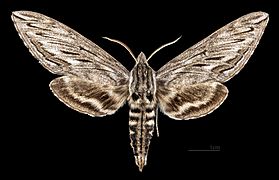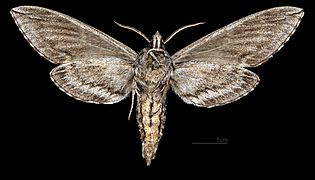Canadian sphinx facts for kids
The Canadian sphinx (Sphinx canadensis) is a cool type of moth. It belongs to a family called Sphingidae, also known as sphinx moths or hawk moths. A scientist named Jean Baptiste Boisduval first described this species in 1875.
Quick facts for kids Canadian sphinx |
|
|---|---|
 |
|
| Scientific classification | |
| Synonyms | |
|
Contents
Where Does the Canadian Sphinx Live?
You can find the Canadian sphinx moth in the northeastern United States. It also lives further north in Canada, reaching places like Newfoundland and Labrador.
What Does the Canadian Sphinx Look Like?
Adult Canadian sphinx moths have a wingspan of about 70 to 85 millimeters. That's about the length of a credit card!
It's easy to mix up this moth with another one, the hermit sphinx (Sphinx eremitus). They live in some of the same areas. But here's a trick: the Canadian sphinx does not have a white spot that the hermit sphinx usually has.
Moth Colors and Patterns
The front wings of the Canadian sphinx are a gray-brown color. They have black lines that look like streaks along the veins. These streaks are broken up by white lines near the outer edge of the wing.
The back wings are different. They have cool patterns of black and white bands.
Life and Habits of the Canadian Sphinx
Scientists used to think that the caterpillars of this moth ate leaves from both white ash (Fraxinus americana) and blueberry (Vaccinium) plants. But new observations show that they mostly eat only one type of plant: black ash (Fraxinus nigra). These trees often grow at the edges of wet, swampy areas.
What Do Adult Moths Eat?
Adult Canadian sphinx moths like to drink nectar from certain flowers. Their favorite nectar sources are Phlox species and a plant called bouncing bet (Saponaria officinalis).
When Do They Fly?
These moths fly later in the year compared to many other sphinx moths. You'll most likely see adult Canadian sphinx moths in very late July or early August.
Caterpillar Camouflage
The caterpillars of the Canadian sphinx have black patches on their sides. Scientists believe these patches help the caterpillars blend in. They might look like the curled-up leaves of the black ash tree, helping them hide from predators.



